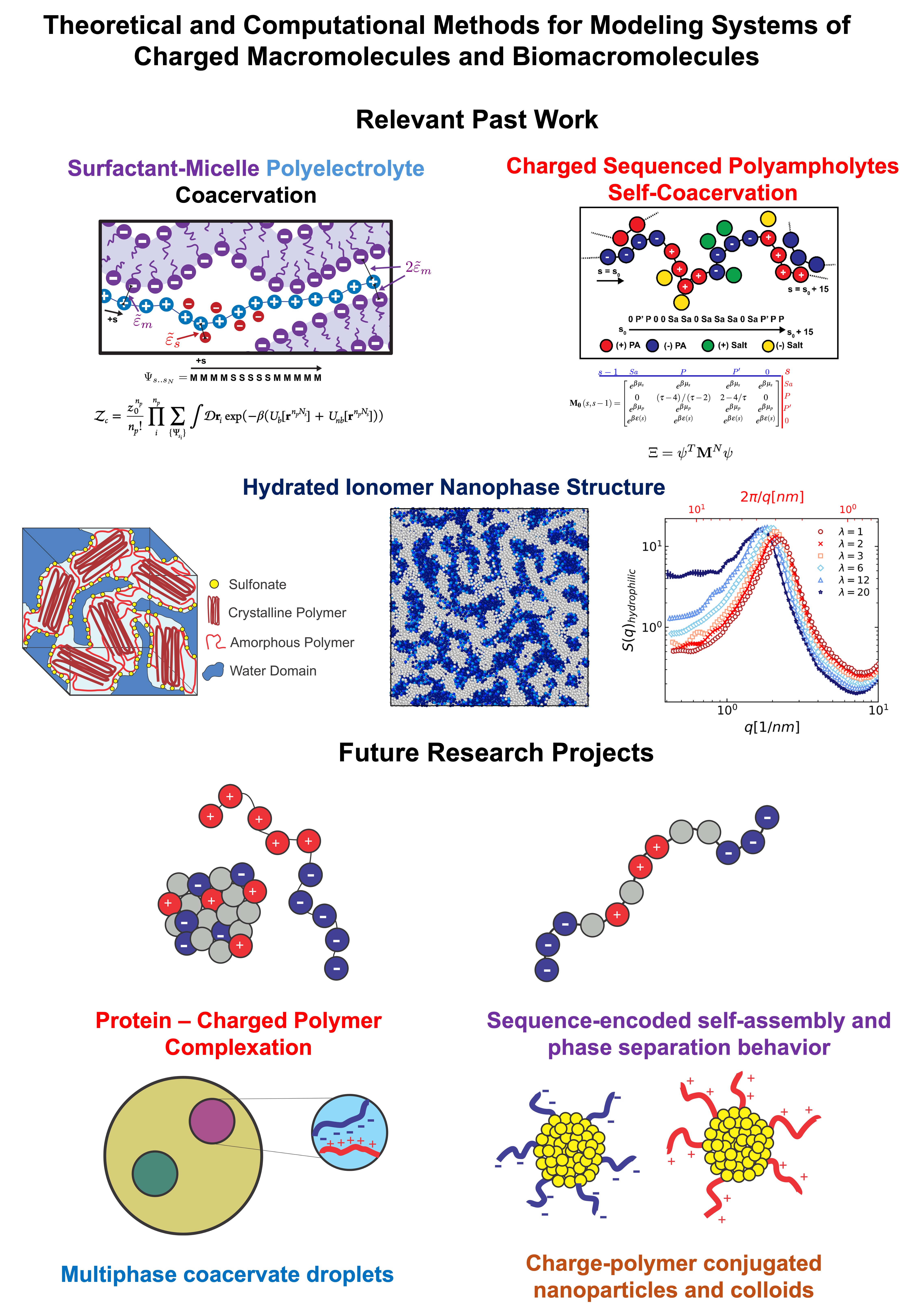2024 AIChE Annual Meeting
(4ea) Developing Theoretical and Computational Methods for Modeling Systems of Charged Macromolecules and Biomacromolecules
Author
Phase separation and self-assembly in charged macromolecules are phenomena which underpin the development of critical technologies and soft materials for membrane separations1, protein purification2 and stabilization3, biomimetic therapeutics4, and drug delivery vehicles5 amongst many other applications. In fact, many biological processes rely on the phase separation and self-assembly of charged biomacromolecules such as DNA, RNA, intrinsically disordered proteins, etc6. I am interested in developing computational and theoretical methods for describing self-assembly and phase separation in a variety of charged-macromolecular systems including synthetic polymers, biological macromolecules, and bio-inspired materials. My research group’s initial focus will be on studying (1) complexation between charged polymers and globular proteins, (2) encoding self-assembly and phase separation behavior in charged polymers through charge sequence, (3) modeling multiphase coacervate droplets, and (4) tuning assembly of charged polymer conjugated nanoparticles and colloids. I will leverage the expertise and experience I’ve developed throughout my graduate and postdoctoral studies in modeling phase separation and self-assembly in charged macromolecular systems using molecular simulation and polymer theory.
I earned my Ph.D. in Chemical Engineering from the University of Illinois at Urbana Champaign under the advisement of Prof. Charles Sing. I worked on developing simulation-informed theoretical models for describing coacervation in charge-sequenced polyelectrolytes and polyampholytes, as well as systems of anionic surfactant micelles and polyelectrolytes. During my graduate studies, I applied for and was awarded the NSF GRFP fellowship. I am currently a postdoctoral fellow under the mentorship of Prof. Arthi Jayaraman at the University of Delaware, with whom I am developing coarse-grained models to study hydrated ionomer nanophase structures, surface-grafted polyelectrolyte behavior and design rules, and designing charged and thermoresponsive copolymers to mimic the proteoglycan aggrecan. During my postdoc, I applied for and was awarded the NSF Mathematical and Physical Sciences Ascending Postdoctoral Research Fellowship (MPS-Ascend) to pursue the work on developing aggrecan mimetic copolymers in a collaborative effort with Prof. Laure Kayser (University of Delaware).
Teaching Interests
Throughout my Ph.D. and postdoc training, I’ve had several opportunities to become involved in teaching. This includes serving as teaching assistant during my Ph.D. for a graduate-level coarse in Thermodynamics and Statistical Mechanics, as well as the undergraduate Unit Operation Laboratory course. Additionally, I’ve had the opportunity to develop and lead lectures in a course on Thermodynamics and Statistical Mechanics and twice in a course on Computational Methods and Simulations in Polymers and Soft Materials. I was very fortunate to have student feedback be collected and provided to me after my lectures so that I can improve my teaching skills and understand how my teaching style is received.
From my experiences in coursework and research, I have developed a passion for programming and thermodynamics. I believe I will be well suited to teaching coursework in computational methods, molecular simulations, polymer physics, thermodynamics, and statistical mechanics. In addition to these topics in which I am most experienced in, I am also confident in my abilities to teach other courses in chemical engineering, including fluid dynamics, mass and energy balance, and heat and mass transfer. I would also welcome the opportunity to develop special topics courses in charged polymer physics and statistical mechanics of soft materials.
Commitment to Diversity, Equity, and Inclusion:
Throughout my training in higher education, I’ve participated in numerous programs for underrepresented minorities in STEM that focus on diversity, equity and inclusion and provide workshops in teaching and mentoring. Some of these programs include the Summer Predoctoral Institute at the University of Illinois at Urbana Champaign, the Institute of Teaching and Mentoring, the Alfred P. Sloan Foundation Minority Ph.D. Program, and the ASCEND Mentorship Network. My participation in these programs not only provided me with workshops and lessons on many aspects of teaching, research and life in academia; but it also brought me in contact with a diverse group of peers from different backgrounds and fields of study. I am guided by my own experiences as a Hispanic, first-generation American and college student. I started on my journey in academia at my local community college and throughout my studies I’ve had amazing mentors who have helped me reach the point where I am now pursuing faculty jobs. I am motivated to provide that mentorship and guidance to help underrepresented students achieve their goals in their studies. Furthermore, I seek to provide research opportunities to students from institutions where these opportunities can be difficult to access such as community colleges and minority-serving institutions.
Works Cited
(1) Kusoglu, A.; Weber, A. Z. New Insights into Perfluorinated Sulfonic-Acid Ionomers. Chemical Reviews 2017, 117 (3), 987-1104. DOI: 10.1021/acs.chemrev.6b00159.
(2) Xu, Y.; Mazzawi, M.; Chen, K.; Sun, L.; Dubin, P. L. Protein Purification by Polyelectrolyte Coacervation: Influence of Protein Charge Anisotropy on Selectivity. Biomacromolecules 2011, 12 (5), 1512-1522. DOI: 10.1021/bm101465y.
(3) Blocher McTigue, W. C.; Perry, S. L. Protein Encapsulation Using Complex Coacervates: What Nature Has to Teach Us. Small 2020, 16 (27), 1907671. DOI: https://doi.org/10.1002/smll.201907671.
(4) Levin, A.; Hakala, T. A.; Schnaider, L.; Bernardes, G. J. L.; Gazit, E.; Knowles, T. P. J. Biomimetic peptide self-assembly for functional materials. Nature Reviews Chemistry 2020, 4 (11), 615-634. DOI: 10.1038/s41570-020-0215-y.
(5) Johnson, N. R.; Wang, Y. Coacervate delivery systems for proteins and small molecule drugs. Expert Opinion on Drug Delivery 2014, 11 (12), 1829-1832. DOI: 10.1517/17425247.2014.941355.
(6) Dignon, G. L.; Best, R. B.; Mittal, J. Biomolecular Phase Separation: From Molecular Driving Forces to Macroscopic Properties. Annual Review of Physical Chemistry 2020, 71 (Volume 71, 2020), 53-75. DOI: https://doi.org/10.1146/annurev-physchem-071819-113553.
